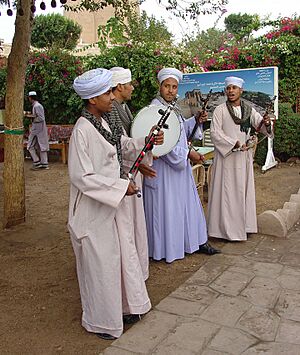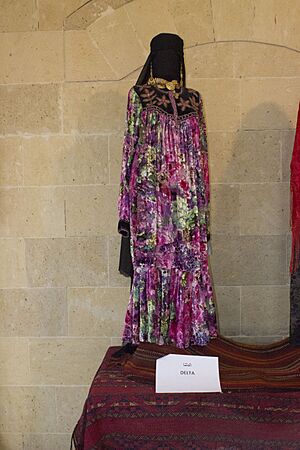Jellabiya facts for kids
The jellabiya (also called jalabiya or galabeya) is a loose, traditional robe. It comes from the Nile Valley, which includes countries like Egypt and Sudan.
Today, many farmers in Egypt wear the jellabiya. It comes in many bright colors there. People in Sudan also wear it, but their jellabiyas are usually white and have different textures. Some people in Eritrea and Ethiopia wear it too. In Egypt, both men and women wear the colorful style.
Contents
What is a Jellabiya?
The jellabiya is different from the Arabic thawb. It has a wider shape and usually no collar. Its sleeves are also longer and wider.
Farmers' jellabiyas often have very wide sleeves. They also have hidden pockets. These pockets are used to carry small things like tobacco or money.
Along the Red Sea coast in Egypt and Sudan, people sometimes prefer the Arabic dishdash. This is because the jellabiya is often linked to farming.
Colors and Fabrics
In summer, jellabiyas are usually white to stay cool. For winter, people wear thicker fabrics. These might be grey, dark green, olive, blue, or tan. Some winter jellabiyas also have stripes. People often wear colorful scarves around their necks with them.
Traditionally, the jellabiya is worn with an ammama, which is a type of turban.
Men's Jellabiya
Men's jellabiyas in the countryside of Egypt often have wider hems and sleeves. They also have a wide neckline with a slit. In cities, they usually have buttons instead of a simple slit.
Men's jellabiyas are usually plain, dull colors, or have stripes or plaid patterns. Women's jellabiyas are often bright colors or prints. In summer, men's jellabiyas are made of cotton. In winter, they are made of flannel or wool and are darker.
Some men's jellabiyas have collars. The galabeya frangi has a Western-style shirt collar. The galabeya scandarani (from Alexandria) has a stand-up collar. These styles also have chest pockets and a tighter fit. They are seen as more modern.
In Sudan, a full men's outfit often has three parts. These are the jibba, the kaftan, and the sederi.
- The jibba is the outer layer. It has a long opening down the chest.
- The kaftan is worn underneath. It protects against heat and cold. It is made of cotton to be comfortable.
- The sederi is a vest worn between the jibba and kaftan. It has small pockets for items like money.
- People usually wear a traditional kamees (shirt) and a sirwal (loose trousers) under these three layers.
Women's Jellabiya
Women's jellabiyas in Egypt vary by region. There are two main styles:
- The galabeya bi wist (with a waist).
- The galabeya bi sufra (with a yoke and loose fit).
The galabeya bi wist has a top part (bodice) and a separate skirt. The skirt can be gathered or bell-shaped. It usually reaches between the knee and the floor. The waist is often higher to allow for pregnancy. Sleeves are usually three-quarter length or longer. Necklines can be V-shaped, square, or open.
The galabeya bi sufra has long, full sleeves. Its main differences are in its decorations, the shape of its yoke (the fitted part around the shoulders), and how it closes. The back often has vertical folds called ḍafāyir. These folds look like the two braids many women wear.
Regional Styles
In the Nile Delta, galabiya bi sufra often have sleeves that get narrower towards the wrist. They might have extra fullness at the upper arm. Some sleeves have three tucks (folds) along their length. Skirts are usually gathered and flared. They might have ruffles or small pleats. Sometimes, the skirt has a "train" that sweeps the ground. This can help keep the back of the leg covered when bending over.
In the Behera region, women's jellabiyas often have wide piping (decorative trim) on the chest in a different color. The neckline is usually square. The dress is gathered, with three tucks at the front to manage the fullness. The bottom of the dress has a ruffle about 8 inches tall. The sleeves are full with tucks. These dresses are always colorful.
In Kirdasa, the traditional dress is a galabiya bi sufra made of floral fabric. It used to have a beaded yoke, but now dresses are often plain brown, blue, or black.
Women in Behera, especially those of Bedouin origin, prefer large, colorful prints. They wear the galabiya bi sufra with different necklines. The square neckline often has a contrasting fabric insert and trim. The V-neckline uses trim to decorate the yoke. Sleeves have three round tucks at the top. The skirt has a large ruffle and vertical tucks at the front.
In Giza, the malas dress was worn as casual clothing. It was made of silk, dyed red, and then black. In Abu Rawwash, the dress was a colorful galabiya bi sufra with a beaded yoke. Shiny fabrics were popular. Today, darker fabrics are more common. Golden beads and rhinestones are often used. Some beaded patterns include the kirdan (stylized flowers) and namisa (rows of beads with zig-zag lines).
The foll trim is named after a fragrant flower. This flower was once used to make scented necklaces in Egypt.
See also
 In Spanish: Galabiya para niños
In Spanish: Galabiya para niños
- Ammama
- Bekishe
- Burnous
- Djellaba
- Hijab
- Jilbāb
- Thawb
- Shalwar kameez




